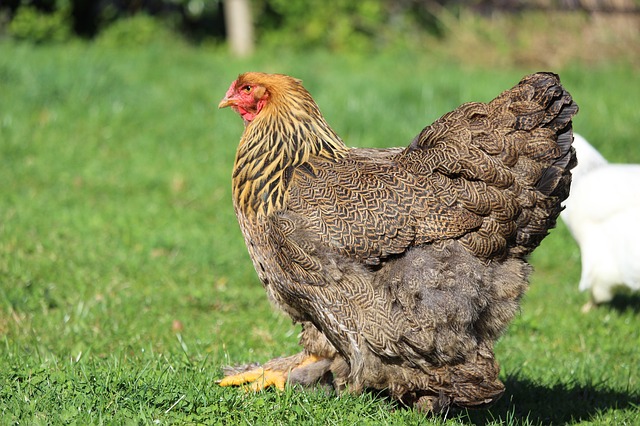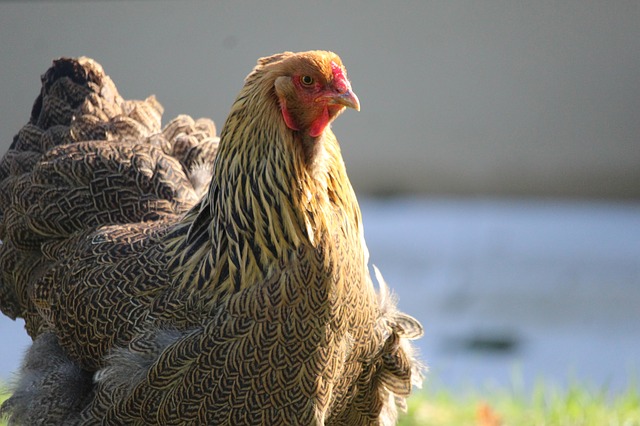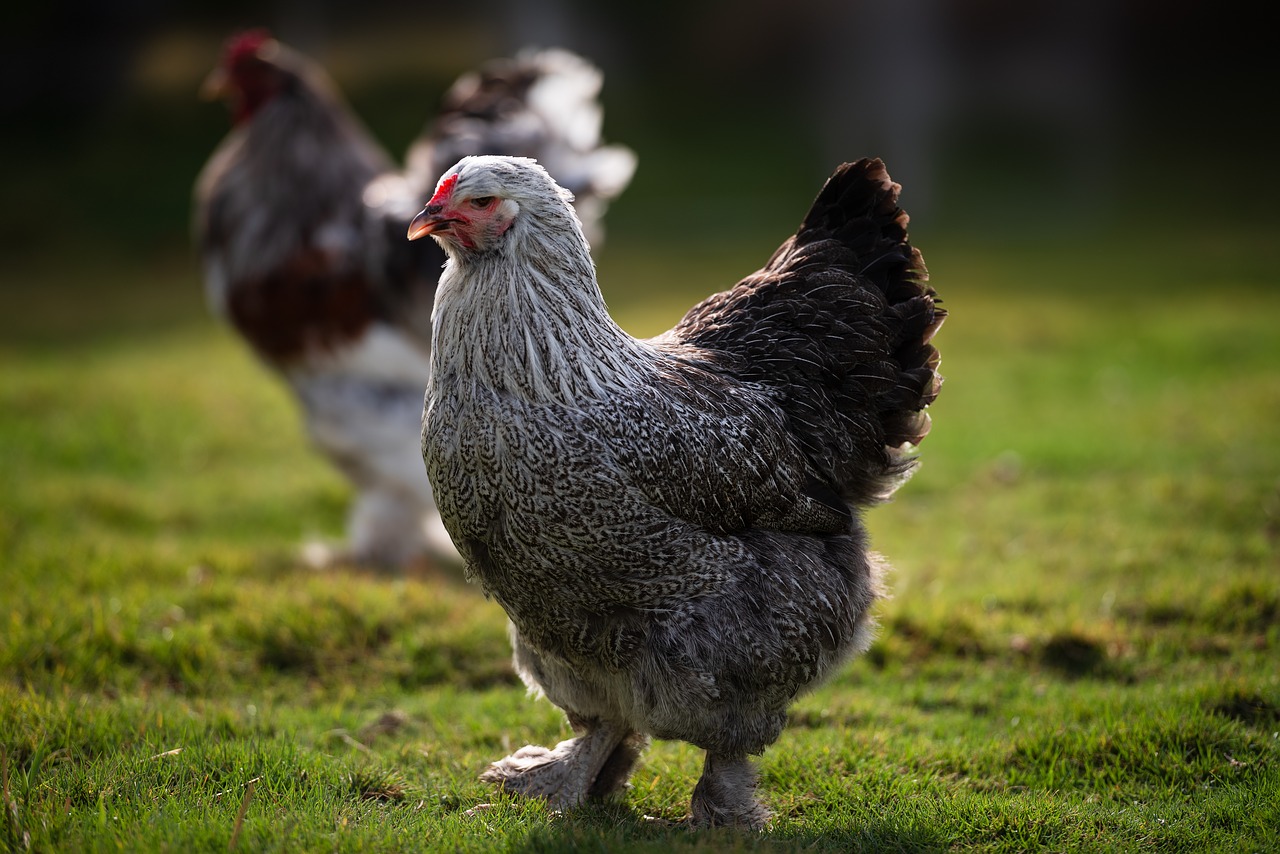The Brahma chicken – the gentle giant of your chicken coop.
This bird is known for its impressive size and its elegant appearance, and despite its hulking stature, will actually be the most peaceful bird in your chicken coop.
A classic American chicken breed, the Brahma chicken is a popular breed among hobbyists and breeders alike, laying a prolific number of brown eggs.
These birds are easy to tame and enjoyable to raise, making them the breed you should be raising in your backyard chicken coop.
Here is a comprehensive overview of everything you need to know about this illustrious bird.
Brahma Chicken Overview
Here’s an overview of this chicken breed’s qualities to help you decide if they’re a good fit for you.
| Lifespan | 5 to 8 years |
| Weight | 10 to 12 pounds |
| Appearance | Light, buff, or dark feathers with a pea comb and feathered feet |
| Egg Color | Brown |
| Egg Production | 4 to 6 eggs per week, 150 to 300 per year |
| Good for Beginners? | Yes |
| Minimum Coop Size | 4 square feet per bird |
| Price | $4 to $12 per chick |
The Background & Origin of Brahma Chickens

There is substantial controversy over the exact origins of the Brahma chicken, but it is widely accepted that these birds were bred in the United States from large birds with heavily feathered legs.
The latter species were likely imported in the 1840s from the Chinese port of Shanghai and were referred to largely as Shanghai birds. The named Brahma refers to the Hindu God of Creation, but it’s unclear why this breed received such an important name.
These Shanghai birds were probably bred with Grey Chittagong birds of Malay origins, which gave the Brahma distinctive pea comb and head shapes.
Originally, there were dozens of different names and strains of this bird, leading to the formation of the Brahmapootra breed in 1852. It was later shortened to Brahma.
Beginning in the 1850s until about 1930, the Brahma chicken was the primary breed for meat production in the United States.
This was because early birds were very large, with roosters weighing up to 18 pounds in some cases!
The earliest versions of the Brahma chicken, which were the dark and light Brahma variants, were included in the Standard of Perfection for the American Poultry Association in 1874, with the Buff Brahma variant added in the 1920s.
Today, this breed, which is officially recognized by the American Poultry Association, is considered a heritage breed.
The Livestock Conservancy recognizes them as “recovering,” for a long time dropping from popularity but experiencing a resurgence in growth as they become more popular with backyard chicken keepers.
Appearance & Characteristics of Brahma Chickens
While there will be some variation among the individuals of the species, these are some general similarities in appearance of the breed.

Size
These chickens are quite large, but there is a misconception that they are enormous compared to other birds in a flock.
While this is true, they won’t be able to hold their own against a group of ostriches any time soon!
Though large, with some members of the breed growing as tall as 30 inches, this massive growth pattern is exceptionally rare and relies on very specific breeding procedures.
Brahmas are indeed large, but not quite so absurdly so. Yet, they are one of the largest chicken breeds.
Usually, this chicken breed will be more variable in size, ranging from 8 to about 18 inches in height. You can also purchase bantam Brahma breeds that are about six inches tall.
On average, these birds will reach about 12 pounds for roosters and 10 pounds for hens.
Colors
There are three colors of Brahmas you can choose from when you are building your flock.
Each of these three colors is officially recognized and include Light, Buff, and Dark.
These birds have feathers on their toes and shanks as well as gorgeous pea combs. Their plumage is smooth and consists of dense down all over the body.
They also have a broad, wide head with a skull that sits out over the eyes.
If you purchase a light Brahma, it will have a base color of white with black and white hackles and a black tail.
The roosters of this variety will have black stripes on their saddle feathers.
The Dark Brahma exhibits the greatest differences between hens and roosters, with a dark gray hen and a black rooster.
The Dark Brahma will also have white-shouldered wings and primary feathers that are edged with white.
The Buff Brahma is similar to the light Brahma but has a golden buff base color instead of one that is white.
There are also rarer Brahma varieties that you can pursue. While they aren’t largely accepted in the United States, the Australian Poultry Association recognizes partridge, blue, black, crele, and barred varieties of Brahma.
What Is It Like to Own a Brahma Chicken?
Again, each Brahma chicken will have a slightly different personality depending on its individual demeanor.
Here are some general commonly shared traits.
Personality
Brahma chickens are very friendly and can be trained to enjoy the company of humans.
All you need to do is feed them lots of treats, and they’ll crawl right into your hand for a cuddle or a snack.
These birds are quiet and docile and get along with other breeds of chickens, too.
Even the Brahma roosters are peaceful, and not as likely to attack humans or other birds as those from other chicken breeds.
Brahmas are stately and elegant in their demeanors. They stand upright and seem to form a V when they are standing.
Although males tend to be taller than females, both genders have strong feet and even stronger posture.
Brahma chickens, even roosters, tend to be very quiet, making them a good choice for an urban or suburban setting.
Broodiness
Brahma hens rarely become broody, but this depends on the individual hen, as it does with all breeds of chickens.
What’s important to recognize is that Brahma hens are more likely to exhibit broody behavior if another hen has gone broody, leading to a copycat pattern that can quickly spread amongst your entire flock.
If your Brahma hen goes broody, let her hatch her own eggs – you can candle them to make sure the embryos are developing. Just keep an eye on the eggs.
These birds are so large that they often accidentally trample their own eggs or baby chicks once they hatch.
Interactions With Others
Interestingly, Brahma hens tend to be favored by roosters when they are part of a larger, mixed flock.
In general, Brahma roosters won’t be destructive or threatening to your hens, but roosters of other chicken breeds can be so it’s important that you keep an eye on your girls to make sure they aren’t hurt by the rooster.
If your hen begins to lose feathers as a result of a rooster’s pursuits, feed her a high protein supplement to encourage them to grow back.
Health and Wellbeing
Brahmas occasionally develop mud balls or fecal balls on their toes. These are not only unsanitary, but they can be dangerous.
Caused by their excessive foot feathering, these mud balls can cause the loss of nails or tips of toes.
Make sure you inspect the feet of your chickens on a regular basis and remove any mud balls you find.
Egg & Meat Yields of Brahma Chickens
If you decide to raise a Brahma chicken, know that it can be raised for multiple purposes.
Although this breed of chicken originated as a meat production species, it is now frequently reared for egg production as it is so productive and docile to raise.
Meat
As a meat bird, the Brahma is beyond comparison.
This unusual-looking chicken is exceptional hardy, making it resilient in both the summer and winter months.
You can kill a Brahma broiler at about eight to ten weeks of age, although they are most profitable at eight months.
There are even reports of the successful butchering of Brahma roasters at twelve or thirteen months of age without loss of flavor.
This is rare, as the meat of most broiler birds will decline in quality when the birds are about eight or nine months old.
Eggs
Raising Brahma hens for meat is one of the more common uses of this gorgeous chicken.
They lay lovely brown eggs (sometimes dotted or speckled with white) that are relatively large compared to those of other species.
The yolks, in particular, are exceptionally large and great for using in cooking or baking.
They are also prolific layers, giving you between 150 and 300 eggs per year or four to six eggs each week.
The exact number of eggs will vary, of course, depending on the individual, but you can increase the egg laying ability of your flock of Brahmas by providing them with secure homes and nesting boxes as well as quality layer feed with at least 16 percent protein and plenty of calcium.
Most chickens don’t usually lay during the shorter days of the year unless you provide supplementary light.
However, Brahmas are the exception.
These prolific winter layers produce an impressive amount of eggs between October and May.
They thrive in cold weather and simply need proper living conditions in order to continue laying during the winter months.
Your Brahma hens will also need a finely tuned diet with proper portions of protein in order to maintain a reliable egg laying schedule.
These birds usually start laying at around six or seven months of age.
They aren’t early layers, but can instead take up to twelve months to begin laying.
This is especially true if your Brahma hen is large or if she comes into egg-laying age during the winter.
Ideal Living Conditions for Brahma Chickens
These large birds need a fair amount of space due to their size. At least four square feet per bird in the coop is ideal, but include extra space if you’re able.
They can live in confinement with other types of chickens, however, having very docile, calm personalities.
They don’t need to scratch or free range as often as other breeds, being very laid back. Brahmas are also easy to contain, as they can’t fly well. So, they can’t scale low fences, and they won’t fly away if there’s no fence.
This is largely due to the breed’s massive size and complacency in being housed in confinement.
Brahma chickens were developed for northern climates and are arguably the least susceptible breed to cold and exposure.
Most breeders suggest that this is due to its pea comb as well as its tight feathering and extensive down.
While it can easily overheat in the hot summer weather, you can avoid this by providing your Brahma chicken with plenty of shade and water during the warmer months.
Brahmas stay the healthiest when they are raised in a damp, cool climate.
They also need to be housed on dry, well-draining soil in order to avoid the development of disease.
Because they have feathers on their toes and shanks, damp or muddy ground can lead to an increased likelihood of infection or frostbite in cold weather.
Benefits of Raising Brahmas
There are countless benefits to raising these chickens, with perhaps the most notable being their ability to:
- Lay up to 300 eggs per year
- Interact peacefully with humans and other members of the flock
- Produce high meat yields
- Thrive in confinement with minimal free-ranging
However, perhaps one of the greatest benefits of raising a Brahma chicken is that these birds are adaptable to most climates, meaning you can raise a Brahma chicken no matter where you live.
Although they have thick feathering that makes them somewhat sensitive to hot weather, as long as you do not live in the tropics, you can likely raise healthy Brahmas.
Being exceptionally cold tolerant, with a heavy weight and feather distribution, these birds stay warm in cold temperatures.
As an added bonus, their egg production rarely slows during the winter months, making them a good choice if you want to maintain a steady supply of eggs when the temperature drops.
Challenges of Raising Brahmas
While there are countless benefits of raising Brahma chickens, there are a few factors to consider that may dissuade you from this pursuit.
Slow Maturation
Brahma chickens make excellent meat and egg birds – but you have to wait for it.
These chickens grow slowly, which is why they are often overlooked as a potential backyard chicken species.
They won’t start laying eggs until six to seven months of age (compared to four or five for other chicken breeds) and they won’t be fully grown for the stew pot until they are older, either.
Overly Friendly Brahma Roosters
If predators are a concern, a Brahma rooster won’t do much to help you.
These roosters are incredibly friendly, making them an excellent choice if you want a more docile flock.
However, they will not protect the flock from a dog, fox, or hawk.
Large Size
The size of the Brahma chicken cannot be emphasized enough.
These birds are jumbo-sized, meaning they eat a lot, too.
Your feed conversion ratios will not be as profitable, as they are so slow to mature, and it may be difficult to find space for them in the chicken run and coop.
Sensitivity to Mud
If you have heavy, clay soil, a Brahma chicken might not be for you.
These birds don’t hold up well to heavy mud, because their feathers are so dense.
If you are able to raise your Brahma chickens on green grass, you shouldn’t have a problem, but keep the health needs of this chicken in mind before you take the leap in purchasing one.
Baby Brahmas: Raising Brahma Chicks
There is little you need to know about raising Brahmas as chicks – they require the same conditions as other young chickens.
If you are hatching your own chickens from an incubator, know that these large fowl can take a bit longer to hatch (a few hours, in most cases).
Otherwise, the hatching procedures and advice for raising these birds is the same as with other breeds.
After they hatch, you will need a special brooder box with plenty of fresh, clean bedding, water, and chick starter feed.
This brooder box should be at least eighteen inches – higher is better.
Your chicks will need at least one-half square foot of space for the first two weeks, but after the first two weeks, they will grow rapidly and will need one square foot per bird.
It’s best to provide this space in advance so you don’t have to move your chicks.
Cover the box with a screen to eliminate the likelihood of drafts (and other pets!) getting into the box.
You should provide your birds with a heat lamp or a heat plate, set at just under 100 degrees for the first few days, with the temperature decreasing by about five degrees each week until they are ready to go outside.
Frequently Asked Questions
Are Brahmas the right birds for you? Here are a few questions you might have before making that decision.
How Long Do Brahma Chickens Live?
Most Brahma chickens live 5 to 8 years, however, it’s not uncommon for them to reach 10 or even 12 years with proper care.
What Chickens Have Feathered Feet?
Other than Brahmas, some chicken breeds with feathered feet are Booted Bantams, Cochins, Faverolles, and Silkies. Be sure to research each breed before considering buying them.
Will Brahma Chickens Lay in Cold Weather?
Yes, this breed is cold hardy and will usually lay eggs in the winter. If they stop laying eggs when it gets cold, that could be a sign that their living situations aren’t ideal or that they’re unhealthy.
Is the Brahma Chicken Right for You?
Brahma chickens, like all other chickens, have relatively long life spans.
If you are interested in raising a Brahma chicken as a pet, know that it will likely live for about five to eight years, depending on how well you care for it and whether it is being raised for the production of some sort.
You can extend the lifespan of your Brahma chicken by providing it with quality food, water, shelter, and veterinary care.
Ready to purchase a flock of these chickens?
You can find them at a number of chicken hatcheries and breeders that deal specifically with this breed, such as Cackle Hatchery, Meyer Hatchery, and more.
You can also purchase a light, dark, or buff Brahma from a specialty breeder.
Referred to often as the King of All Poultry, this chicken breed would make a fantastic addition to your backyard flock.
If you are ready to raise a gorgeous chicken that can provide you with both meat and eggs, the Brahma chicken is the bird you should include in your backyard flock.
